Instruction
Stickney: To stack or not to stack at impact?

As you look at the impact positions of the best players in the world, you will find many different “looks” with respect to their body and club positions. Some of these impact positions might even appear unique, but don’t be fooled. They all have one thing in common: preserving the players’ balance throughout the impact interval! In fact, if you are not in-balance, then you will lose power, consistency, and have trouble controlling your launch dynamics from shot to shot.
This balance is a necessary key to playing well and one area that can be easily understood with a few graphics shown on GEARS 3D. As you examine the photo in the featured image, you can see a few things:
- The player on the left has “fallen” backwards through impact slightly moving his head out of the circle established at address
- The player on the right is more stacked at impact — meaning that his chest, zipper and hands are all in the same place at the same time (within reason)
- The player on the left has reached this same position in the swing with different segments of the body reaching the ball at different times
- There will be a difference of impact shaft lean between the two players due to one player reaching impact “together” and the other shoving his hands more forward as he falls back
- The player on the right is more “connected” through impact…won’t be the longest hitter but will be able to find the ball in the fairway more often
- The player on the left is putting more pressure on the rear portion of the lower back which could have a potential for injury if he’s not careful
Now, obviously there are pro and cons to both positions. Overall, if you want to be consistent and in-balance more often that not, I would suggest you try your best to focus on being “stacked” when you hit the ball.
Let’s dive in a touch deeper to show you what happens physiologically on 3D when you fall back through impact and I think it will really drive the point home.

- At address notice the Vertical Spine Number 96.2, this is showing us where the spine is positioned at address
- You can see the head is in the center of the bubble

- On the way to the top of the swing you can see that the spine has moved “away” from the target laterally a slight bit to 98 degrees
- The head has dropped downward and has also moved laterally as well- more lean over the right leg to the top
Now here is where the problem comes in…as you work your way to the top, it’s ok of your head moves a touch laterally but in transition if it stays “back” while your hips run out from under you then you will begin to fall backwards on the way to your belt-high delivery position.

- We can see at the delivery position that the spine has continued to fall backwards as the hips rotate out from under the upperbody
- When this happens the hands will begin to push forward- dragging the handle into the impact zone
- Whenever you have too much spin out and fall back the hands move forward to accommodate this motion and this reduces your Angle of Attack and decreases your dynamic loft at impact
- This will cause balls to be hit on the decent of the club’s arc and reduce loft making shots come out lower than normal with a higher spin rate and that means shorter drives
Now let’s examine impact…

- The player on the left has reached impact in a more disconnected fashion versus the player on the right as you compare the two
- The player on the right has a shaft lean at impact that is less than a degree (.75) while the player on the left has a much more noticeable forward lean of the shaft thereby reducing dynamic loft at impact

- The player on the left’s spine has moved from 96.2 to 112.9, a difference of 16.7 degrees while the player on the right has only moved back a few degrees. We know this because his head has stayed in the bubble we charted at address
- The hips have run out from under the player on the left in the downswing and this causes the head to fall back more, the hands to push forward more, and the impact alignments of the club to be too much down with very little dynamic loft (as also shown in the photo below)

Whenever the hips turn out from under the upper body then you will tend to have a “falling back effect of the spine and a pushing forward of the hands” through impact. Notice how the hips are radically more open on the player on the right versus the left- 27.91 versus 42.42 degrees.
So, now that we can see what happens when the hips spin out, you fall back, and you fail to be “stacked” at impact let’s show you a simple way you can do this at home to alleviate this issue.


- A great drill to focus on being more stacked at impact is to make slow motion swings with the feeling that the upper portion of your arms stay glued to your chest
- These shots will be full swings but only 20% of your total power because the goal here is connection which allows everything to reach impact together and in-balance
- The second thought as you make these swings is to pay attention to your head, if you can focus on allowing it to stay “over the top of the ball” at impact you will find that it will stay put a touch more so than normal. Now this is not exactly how it works but it’s a good feeling nonetheless
- Once you get the feeling at 20% speed work your way up to 50% speed and repeat the process. If you can do it here then you are ready to move up to full swings at top speed
Finally, don’t forget that every golfer’s hips will be open at impact and everyone’s head will fall back a touch — this is fine. Just don’t over-do it! Fix this and enjoy finding the ball in the fairway more often than not.
Questions or comments? [email protected]
- LIKE28
- LEGIT3
- WOW0
- LOL1
- IDHT0
- FLOP2
- OB2
- SHANK8
Instruction
Kelley: How the concept of a punching motion can change your golf swing
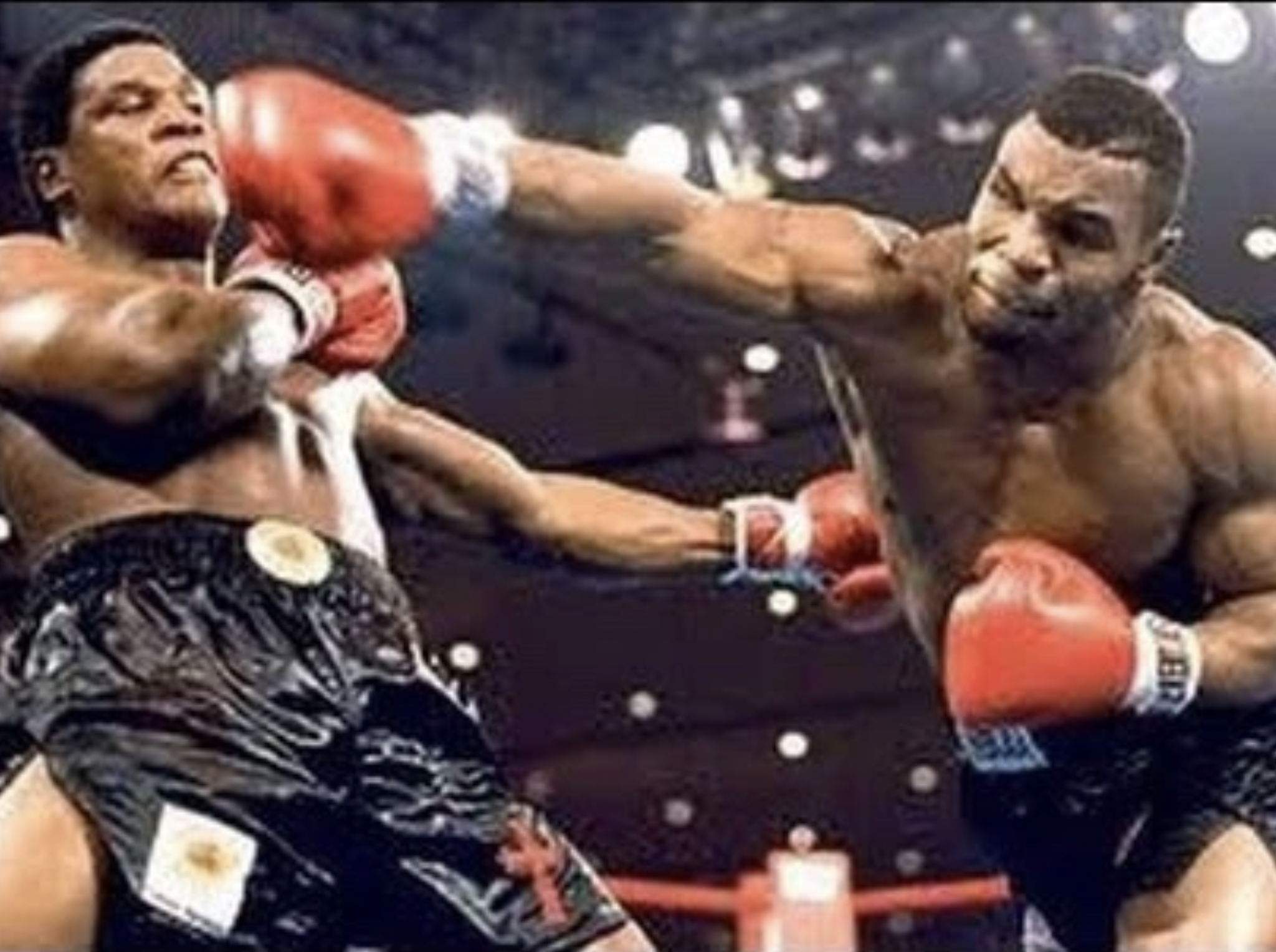
Ever wonder how a simple looking golf swing can produce so much speed and power? The answer may lie in the biomechanics of throwing a punch.
Below is an image of a boxer throwing a right handed hook. Note the direction the body moves to produce maximum force towards the target.
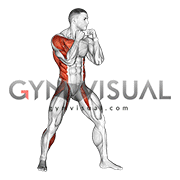
As the boxer pulls back his arm, there is not an excess wind-up or big turn to create power. His body is now geared to go forward and around into the opponent. His body would stay mostly level throughout the motion.
Now lets apply this simple concept to the golf swing. At address, the player would have his upper body and mass positioned behind the ball. In the picture below, note the green line indicting his mass back behind the blue baseline over the ball.
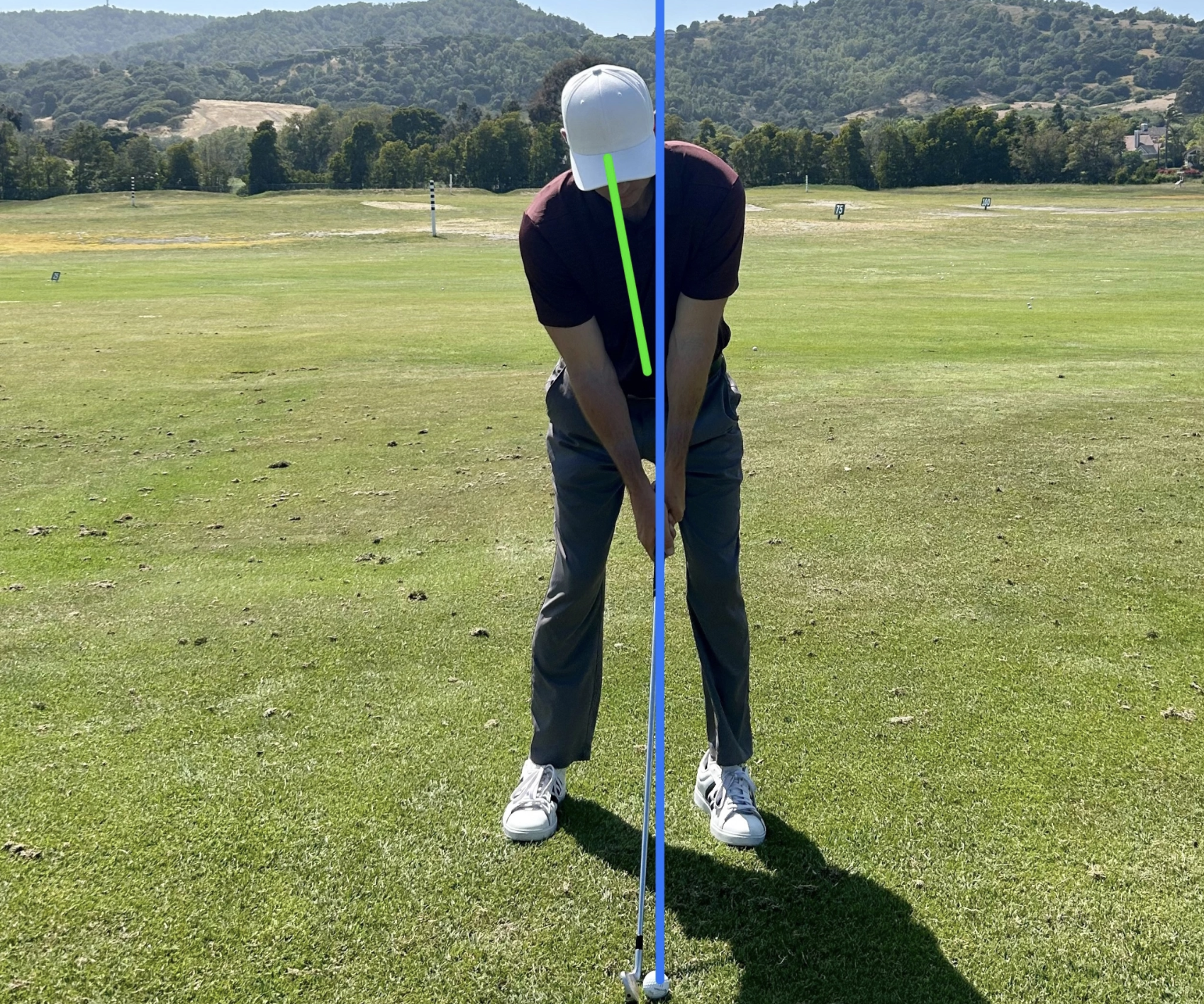
From here, the player can coil around his center, much like a boxer positioned ready to punch.

Now the body can go forward and around towards the target, pulled by the arms. Note the body finishing ahead of the blue baseline.

A body that has a lot of left side bend or “tilt” in the backswing, will naturally counterbalance in the downswing. This will often result with the upper body falling back in the downswing. (Pictured below)
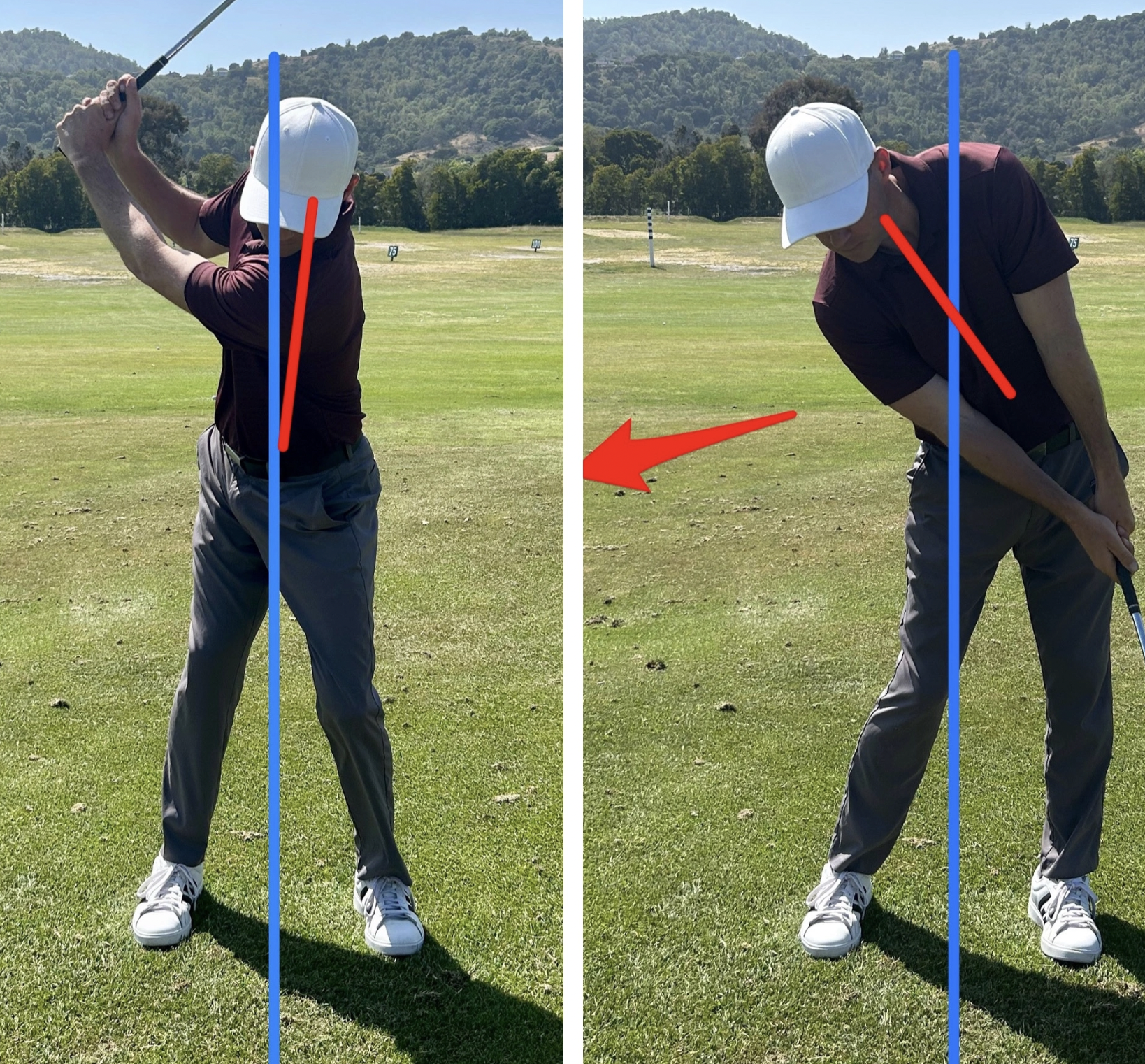
The pattern above would equivalent to attempting to punch forward with your arm while your body is moving backwards. Next time you are looking to make a swing change, first check the movement of your body, and see if it is as simple as boxer throwing a powerful punch.
Twitter: KKelley_golf
- LIKE23
- LEGIT7
- WOW0
- LOL0
- IDHT2
- FLOP0
- OB0
- SHANK7
Instruction
How to set up to the golf ball: Why grip, grip pressure, and posture are crucial
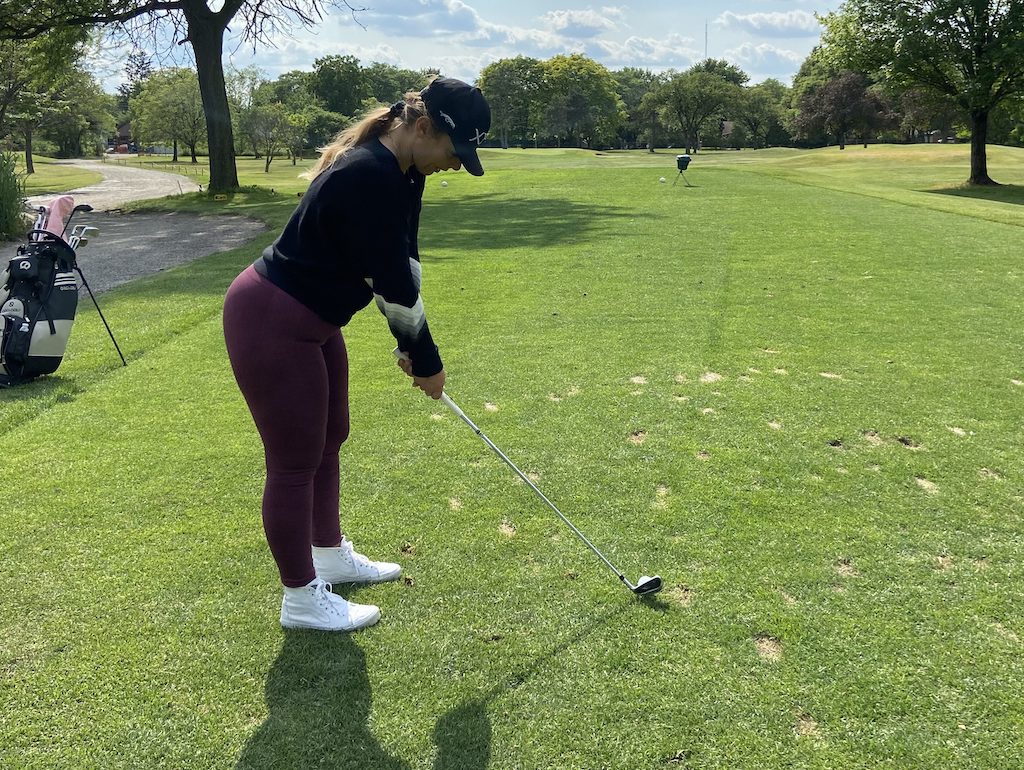
When we are playing a round or hitting balls on the range over a long period of time, we tend to grip the club tighter, stand up, and quickly lose the ability to maintain posture during the golf swing.
As players, with the spine angle out of posture, we overcompensate in many ways. The first thing that many players do poorly, as a result of poor posture, is grip tighter and stiffen the arms. These are the two biggest culprits that will inhibit consistency and any innate ability to set up well and brush the grass. Gripping tighter also leads to poor use of the body’s bigger muscles ie. the core. The spine angle in good posture will activate the core regions and enhance the body’s ability to coil, thus allowing the transfer of weight from the trail to the lead side.
In the quest to better ball striking, our first priority is understanding the importance of grip strength and grip pressure. Our second priority is posture and always initiating the proper spine angle by bowing forward from the hip (pelvic tilt) and letting the arms hang. After positioning the spine angle, check the body’s alignment )ie. shoulders, hips, knees, and feet) by positioning them parallel to the target line. This process composes the beloved and all-important set up.
How to set up to the golf ball: The basics
Our ability to set up and control grip pressure is the source of our ability to play well and consistently over time.


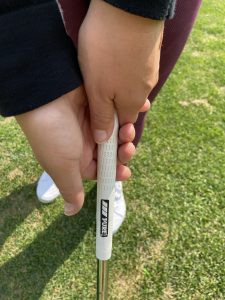
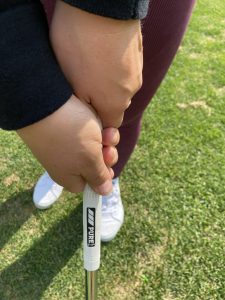
The first essential step is setting the grip in the lead hand
The main pressure points to focus on in gripping with the lead hand are, first and foremost, in the initial placement of the club’s grip in the fingers and allowing the top of the grip to rest on the palms pad. The first pressure point is in the lead pointer finger behind the shaft and the second pressure point is when we let the club rest on the palm’s pad. The lead thumb is the third pressure point. Proper grip strength is determined by trial and error swings.
As we grip the club in the trail hand, it is important to grip lightly and in the fingers with the right thumb pad placed on top the left side of the grip. For reference, there are markings on all golf gloves to help each player understand where their grip should be placed.
The essential second step is bowing from the hips to create the spine angle
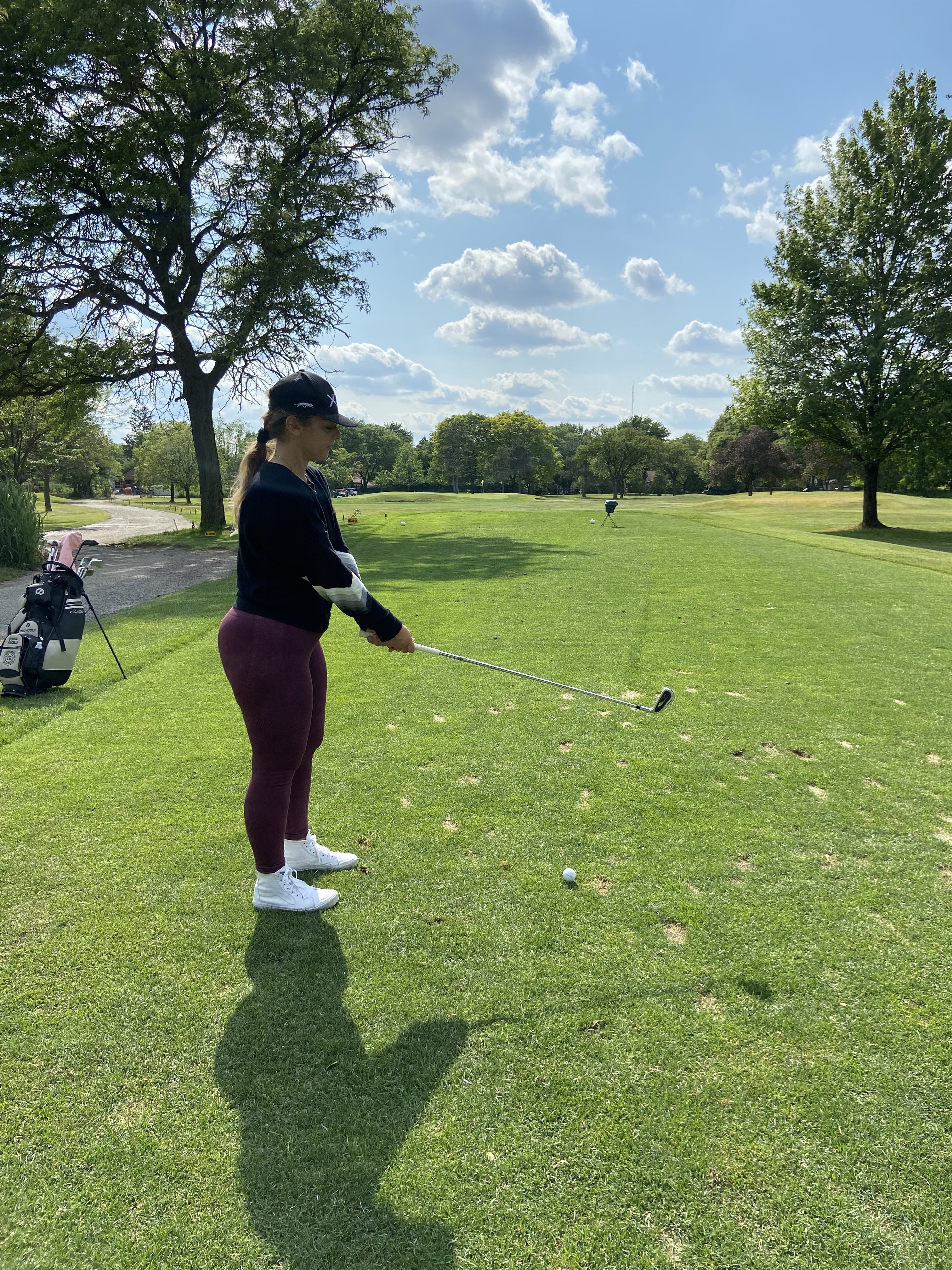

As we bow, the focus is to aim the leading edge perpendicular to the target line. Looking at the first groove of the club (if it is an iron) can help the eyes focus on this step. A lot of mistakes happen when our eyes start looking around while we do this instead of focusing on an intermediate target and using our eyes to line up the leading edge to that point. Being thoughtful in this process is key and just try to make sure the club isn’t wiggling around.
In the bow, with our shoulders just over the toes, we can see if the club is resting in good relationship to the body. Understanding the distance our body should be to the club is huge. This alone can make or break our ability to strike the ball well. Keeping one hand width from our body to the club is a general rule of thumb throughout the entire bag. The space in which we stand to the club shouldn’t change. What changes is the length of the club in our hands.
These components culminate the very first steps we take to hit a shot. This is the essence of set up, which generates our best chances to develop consistent shot patterns to the target. As a result of properly managing these components, we can begin to maintain accuracy and easily repeat our movement patterns to get the ball close to the target. We can also begin to self-correct our misses if we are accountable with these steps.
Foot width and ball position
Lastly, in the set up we step our feet to the ball’s position and generally maintain a stance that is approximately shoulder width. After gripping and bowing the next thing a player needs to do is step to the ball position. This will impact the club’s ability to generate loft, also depending on the chosen club. Generally, a driver ball position is forward in the stance. The mid-iron ball position is mid stance and most full-swing wedges are played just back of center with a more narrow stance. Taking the time to better understand the components of set up and ball position will generate 100 percent of our success to better ball striking.
A final word
Take some videos of yourself and look at the body from head to toe. Is your setup in a ‘Z’ or ‘S’ formation? Where is your weight in your shoes? Heels, mid-shoe, or toes? Does your setup look like an ‘H’or ‘C’? Is your weight too far in the heels or toes? In my experience, it is easier to maintain posture in the golf swing and overall athleticism by keeping the stance’s pressure points more forward in the mid-shoe to the toes. This enhances the pelvic tilt and the arms’ ability to hang. Therefore, posture throughout the swing improves and we are less likely to grip so tight.
Any questions? Book a lesson with LPGA instructor Donna Fiscelli through her booking site.
- LIKE37
- LEGIT8
- WOW2
- LOL1
- IDHT0
- FLOP0
- OB0
- SHANK8
Instruction
Clement: Snap that driver for 300-yard drives!

PGA Tour Coach and Golf Channel Academy instructor, Shawn Clement, shows you how insanely adapt your arm anatomy is to get consistent releases when you allow it to happen in the direction you want the ball to start!
- LIKE4
- LEGIT1
- WOW0
- LOL1
- IDHT0
- FLOP1
- OB1
- SHANK7
-

 19th Hole2 weeks ago
19th Hole2 weeks agoTiger Woods delivered stinging message to major winner after denying him lift on private jet
-
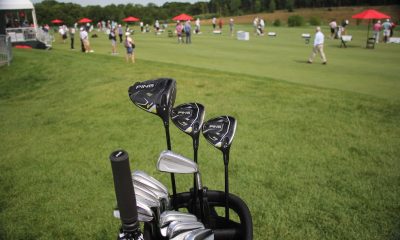
 Whats in the Bag2 weeks ago
Whats in the Bag2 weeks agoSeamus Power WITB 2023 (June)
-

 Whats in the Bag3 weeks ago
Whats in the Bag3 weeks agoOmar Morales WITB 2023 (June)
-

 Whats in the Bag3 weeks ago
Whats in the Bag3 weeks agoBlayne Barber WITB 2023 (June)
-

 Whats in the Bag3 weeks ago
Whats in the Bag3 weeks agoBen Carr WITB 2023 (June)
-
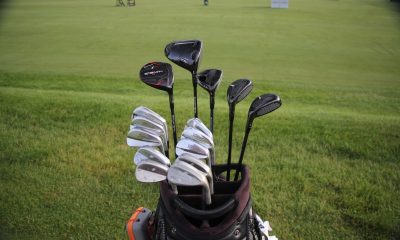
 Whats in the Bag2 weeks ago
Whats in the Bag2 weeks agoTom Hoge WITB 2023 (June)
-
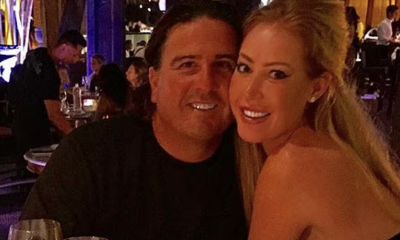
 19th Hole3 weeks ago
19th Hole3 weeks agoJournalist alleges this is the ‘unforgivable’ act Phil Mickelson committed against Pat Perez and his wife
-
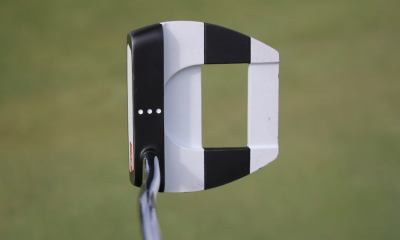
 News2 weeks ago
News2 weeks agoKeegan Bradley’s winning WITB: 2023 Travelers Championship













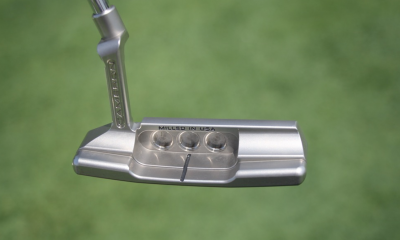

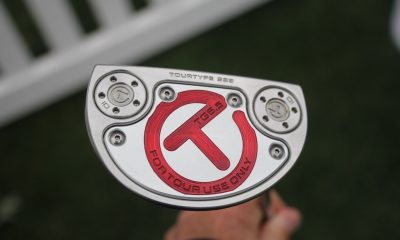

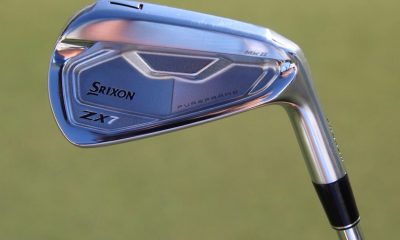

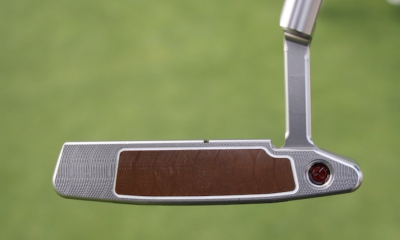

geohogan
Nov 30, 2022 at 11:55 am
Every good golfer have their head as much as 7 inches closer to the ground than at address.
Good golfers allow their hips to move(subconsciously) back away from the ball, offsetting CF.
The head naturally has to lower. (head and hips counter balance in coronal plane)
Poor golf swings counter CF by standing up leading to lower back injury.
Robert Johansson
May 7, 2022 at 1:03 pm
teaching stuck mechanics
The modern golf way